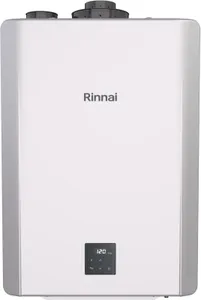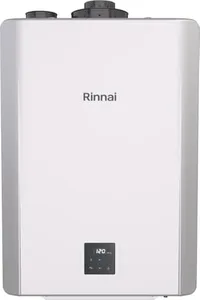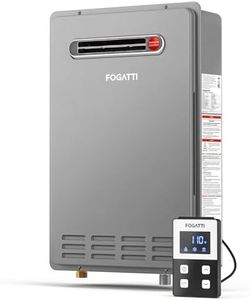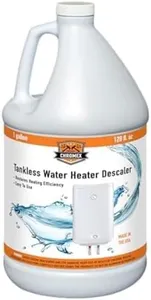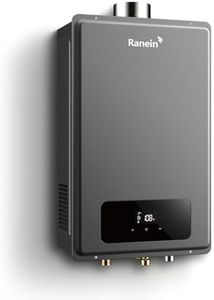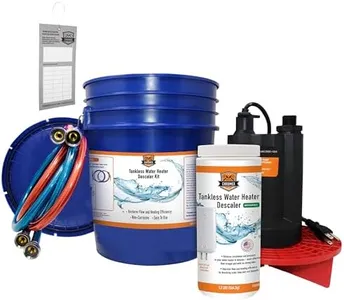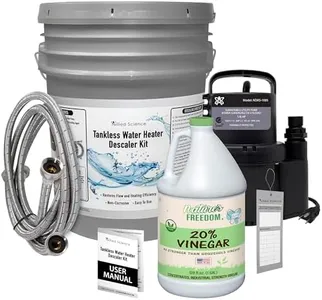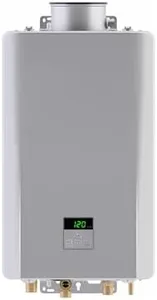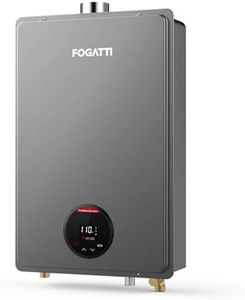10 Best Tankless Gas Water Heaters 2025 in the United States
Our technology thoroughly searches through the online shopping world, reviewing hundreds of sites. We then process and analyze this information, updating in real-time to bring you the latest top-rated products. This way, you always get the best and most current options available.

Our Top Picks
Winner
NEW Rinnai RXP199iN Condensing Smart Sense Natural Gas or Propane Tankless Water Heater, Indoor or Outdoor Water Heater, Up to 11.1 GPM, 199,000 BTU
Most important from
270 reviews
The Rinnai RXP199iN tankless water heater offers a notable blend of versatility and efficiency. Its capacity to deliver up to 11.1 GPM makes it suitable for households with high hot water demands, potentially serving up to seven fixtures simultaneously. This high flow rate, coupled with a substantial 199,000 BTU rating, ensures a consistent supply of hot water even during peak usage times. The energy efficiency factor (UEF) of .98 indicates the unit is highly efficient, contributing to lower energy bills over time and making it an eco-friendly choice.
Additionally, the unit's compact size, comparable to a small suitcase, facilitates flexible installation options, whether indoors or outdoors, thanks to the Versa Vent system and the Smart Sense gas control system accommodating both natural gas and propane. The Smart-Circ Intelligent Recirculation feature is a standout, learning your water usage patterns to optimize efficiency and convenience by scheduling pump and recirculation activities.
While the design is user-friendly with features like an easy-to-use interface and Quick Flush function, professional installation is strongly recommended. This might be a drawback for those looking for a DIY solution and could add to the initial setup cost. Another potential downside is the need for an additional Control-R module for WiFi connectivity, which isn't included with the unit. This water heater is ideal for larger homes or any setting requiring a substantial and steady hot water supply, especially for users who prioritize energy efficiency and modern conveniences.
Most important from
270 reviews
NEW Rinnai RXP160iN Condensing Smart Sense Natural Gas or Propane Tankless Water Heater, Indoor or Outdoor Water Heater, Up to 9 GPM, 160,000 BTU
Most important from
270 reviews
The Rinnai RXP160iN is a versatile tankless gas water heater that can run on either natural gas or propane, suitable for both indoor and outdoor installation with the proper venting. It delivers up to 9 gallons per minute, comfortably supplying hot water to multiple fixtures simultaneously—a good flow rate for medium to large households. Its energy efficiency is excellent, with a UEF rating of 0.97, which helps save on energy costs compared to traditional tank water heaters. The 160,000 BTU output ensures strong heating power, capable of maintaining a high temperature rise even if incoming water is quite cold.
The unit is compact and wall-mounted, roughly the size of a small suitcase, making it a space-saving option for homes with limited installation space. One of its smart features is the internal pump with Smart-Circ technology that learns usage patterns to reduce water waste and improve convenience by delivering hot water faster when needed. Professional installation is recommended, especially because of venting requirements and gas connections, which might increase upfront costs. Additionally, outdoor installation requires an extra vent cap accessory.
The water heater offers WiFi control compatibility through an optional module, although this additional cost and setup may not be necessary for everyone. This Rinnai model is an excellent choice for users seeking reliable, energy-efficient hot water with flexible installation options and smart features, but it requires some technical know-how or professional help to install correctly.
Most important from
270 reviews
NEW Rinnai RX160iN Condensing Smart Sense Natural Gas or Propane Tankless Water Heater, Indoor or Outdoor Water Heater, Up to 9 GPM, 160,000 BTU
Most important from
270 reviews
The Rinnai RX160iN is a versatile tankless gas water heater suitable for both indoor and outdoor use, thanks to its Versa Vent system. It runs on natural gas or propane, offering flexibility depending on your fuel source. With a maximum flow rate of 9 gallons per minute, it can comfortably supply hot water to around six fixtures simultaneously, making it a good fit for medium to larger households. The unit boasts a strong 160,000 BTU rating, which supports a high temperature rise, so you can expect consistent hot water even in colder climates or when multiple taps are in use.
Its energy efficiency is impressive, with a UEF rating of 0.97, meaning it wastes very little energy compared to older models, helping save on utility bills over time. The compact size—about the size of a small suitcase—and wall-mount design make it easier to install where space is limited. However, professional installation is recommended, as venting requirements and gas connections can be complex, especially for outdoor setups. The Quick Flush feature helps maintain system longevity by simplifying maintenance. Optional WiFi connectivity allows for remote control and monitoring if you add the Controlr module, which adds convenience.
One possible downside is that while the product is highly efficient and powerful, it can be pricier than basic models, and the need for professional installation adds to upfront costs. Also, users should ensure their home’s ground water temperature fits the heater's optimal range for best performance. For those seeking a reliable, energy-efficient heater that won’t run out of hot water and can work with different fuel types and installation locations, the Rinnai RX160iN is a strong contender.
